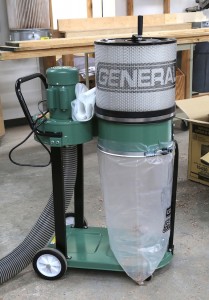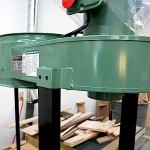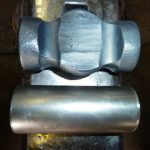We may receive a commission when you use our affiliate links. However, this does not impact our recommendations.
 If you have a shop, you need some type of vacuum or a dust collector. No, a dust collector is not simply attached to a table saw, band saw or router table. It is as perfect to clean up wood dust as it is for shavings from your plane. (If you’re working green wood as you build a joint stool from a tree, there are plenty of shavings to pitch.) While you may not wish to drag a 3-horsepower machine around your shop, it’s just as crappy to have to pull a 4″ hose from a small wall-mounted unit. General International has introduced the perfect machine, model #10-030CF.
If you have a shop, you need some type of vacuum or a dust collector. No, a dust collector is not simply attached to a table saw, band saw or router table. It is as perfect to clean up wood dust as it is for shavings from your plane. (If you’re working green wood as you build a joint stool from a tree, there are plenty of shavings to pitch.) While you may not wish to drag a 3-horsepower machine around your shop, it’s just as crappy to have to pull a 4″ hose from a small wall-mounted unit. General International has introduced the perfect machine, model #10-030CF.
Take a look at the left-hand photo. See the wheels on the bottom of the machine? Those wheels, along with the casters at the front, make rolling this unit around your shop too easy – and for tight-radius turns you can rear up this unit onto the 7″ wheels (what we called a “wheelie” when I was a youngster riding bikes) and make a quick 90° turn. Surely you can navigate around your shop.
As I put this machine together, a couple of things I found as a challenge on older collectors were greatly improved in this machine. General International has made all the connections with screws into threaded plates welded in place. There’s no need to finger a nut on the underside of the machine, and there is no two-wrenching action required.  Except, that is, on the rear wheels, which are attached with bolts, nuts and plastic spacers for a smoother glide.
Except, that is, on the rear wheels, which are attached with bolts, nuts and plastic spacers for a smoother glide.
The bigger convenience is that the impeller/separator assembly has small squared housings that slip over the ends of the support posts. Once in position, it’s hands-free and stays put as you run in the screws. Some of the older units I assembled for my shop had to be held and balanced as you fumbled with a connection of bolts and nuts – you needed three hands or a shop helper.
With the impeller/separator in place, you slip on the one-micron canister filter (a nice add-on for a small collector), position the lower plastic bag onto the small clips found on the unit’s side (another hands-free arrangement), slip on the quick-release metal strap bands and your off and running. Of course, you’ll need a length of 4″ hose and a clamp to attach to the unit.
And all the information listed above means nothing if the 10-030CF dust collector doesn’t collect dust. Well it does. This easily portable, turn-on-a-dime, easy-to-assemble dust collector sucks! (You had to see that coming from a mile away!) This machine can work effectively with your table saw, band saw or any other machine in your shop. It, too, can easily snake through the shop to make general clean-up a breeze.
General International has this collector on sale through August 31, 2013 for $400. The regular price is $575. Now for you machine aficionado-types, here is the technical data:
| Inlet diameter | 4” (102 mm) |
| Airflow capacity | 506 CFM |
| Sound rating | 80-85 dB |
| Static pressure | 6 3/4” OF WATER |
| Blower wheel diameter | 10″ (254 mm) |
| Canister size | 14 1/2″ x 11 3/4″ (370 x 300 mm) |
| Filter area | 20.33 Sq.Ft. |
| Overall dimensions (L x W x H) | 31 1/8” x 18 7/8” x 47 5/8” (790 x 480 x 1210 mm) |
| Motor | 1 HP, 110 V, 7 A |
| Weight | 67 LBS (31 Kg) |
For more information on dust collection, purchase a copy of “Workshop Dust Control.”
Here are some supplies and tools we find essential in our everyday work around the shop. We may receive a commission from sales referred by our links; however, we have carefully selected these products for their usefulness and quality.









Why is it that people that have the cheapest built dust collectors on the planet ( HF ) think that they are dust collection experts ? LOL . In my opinion the Delta 50-760 dust collector is the best bang for the buck. It comes with a 1 micron felt bag that is easy to clean, and the unit is fairly easy to make and add an onboard separator to. Making it a very efficient and affordable portable 2 stage dust collector. https://sites.google.com/site/deltacontractorstablesaw/
I bought a “General International” sliding table saw this past year, and have discovered a number of problems with it, including a rip fence that flexes a bunch and won’t hold a square setting and a serious problem with the safety of the saw. After several calls and emails to General they have been completely unresponsive.
My vote is to to spend your money elsewhere.
I’m sorry Glen – but that piece is an out and out infomercial for the maker. it’s not even close to a review, never mind one based on performance testing. I could start to list the reasons why this is the case, but it’s all been said before….
I have to agree with Redguy. The only thing holding me back from dust collection is the noise. Until technology advances past that hurdle, I’ll be pushing a broom. I don’t think that it’ll be too long though. We just bought a Shark vacuum for the home and I can barely hear it. Of course, that could be my hearing from many years of shop time.
Ok, but also important, particularly for home-shop / small-shop users, what is the unit’s noise level? Currently, I use the ShopSmith cousin of this unit (not because I’m a ShopSmith fan but because of the performance to noise ratio along w/ the maneuverability factor). My ShopSmith unit will not fatigue hearing nor give family or neighbors reason to complain while still delivering acceptable performance. How does the General 10-030CF compare? Also, what does a replacement canister cost? How often will canister need replacing (Glen, maybe you can update us down the road on this one)?
….but how effective is the filter? What is the percentage of 1 micron particles it will capture? and not circulate to the shop air? Isn’t that the real question…
In all the articles I have seen on dust collection, I have yet to see one that mentions the most effective means of dust control. Every DC is rated on CFM and the quality of the filter of the bag. No one has ever mentioned merely ducting the debris stream from the impeller to an enclosed area OUTSIDE the shop. Not only does one not have to deal with the expelled dust from the DC, but the CFM is greatly increased because there is no (or a greatly reduced) impediment to the air stream.
I have a Harbor Freight DC (rated at 1,200 CFM), even when I mounted two 1 micron filter bags on it, the reduction in CFM was markedly noticeable. When I installed a cyclone in the debris stream and ducted the output of the impeller (removed from the DC and mounted above the cyclone) outside the shop into a small building especially built for that purpose (with an appropriate “half moon” on the door) the CFM went up by a good 50%, AND the dust was outside the shop. The entire system uses 4″ PVC.
One further note, I originally had the output of the impeller discharging into a 33gal trash can in the “out house” and had a burlap cover over the can. My thinking was that the burlap was so course that it would stop any “big chunks” but let the air pressure pass through. I was wrong, the burlap clogged with the dust and reduced the throughput. Removing the can and allowing the output of the impeller to discharge directly onto the “out house” floor made a noticeable increase in the overall throughput.
Looks like a neat little machine. Perfect for my little shop. Not having to reach on the underside and finger a nut is promising too….